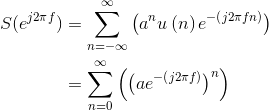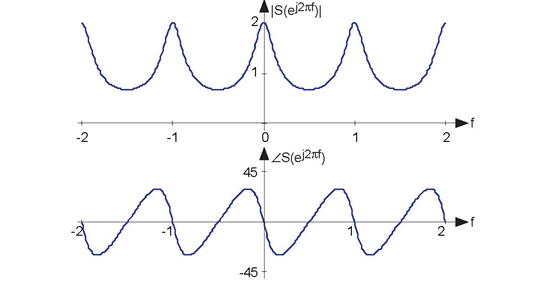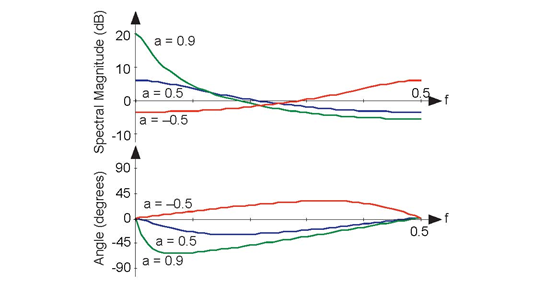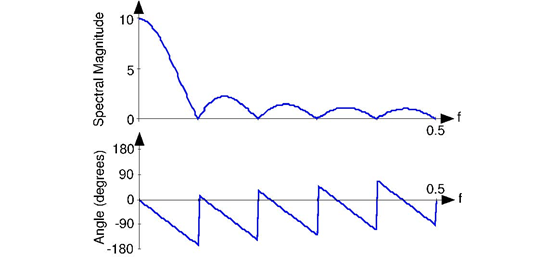The Fourier transform of the discrete-time signal s (n) is defined to be

Frequency here has no units. As should be expected, this Definition is linear, with the transform of a sum of signals equaling the sum of their transforms. Real-valued signals have
conjugate-symmetric spectra:
Exercise 5.6.1
A special property of the discrete-time Fourier transform is that it is periodic with period one:
Derive this property from the Definition of the DTFT.
Because of this periodicity, we need only plot the spectrum over one period to understand completely the spectrum's structure; typically, we plot the spectrum over the frequency
range ![\left [ -\left ( \frac{1}{2} \right ),\frac{1}{2} \right ].](/system/files/resource/9/9648/9755/media/eqn-img_86.gif) When the
signal is real-valued, we can further simplify our plotting chores by showing the spectrum only over
When the
signal is real-valued, we can further simplify our plotting chores by showing the spectrum only over ![\left [ 0,\frac{1}{2} \right ];](/system/files/resource/9/9648/9755/media/eqn-img_87.gif) the spectrum at negative frequencies can be derived from positive-frequency spectral values. When we obtain the discrete-time signal
via sampling an analog signal, the Nyquist frequency (p. 176) corresponds to the discrete-time frequency
the spectrum at negative frequencies can be derived from positive-frequency spectral values. When we obtain the discrete-time signal
via sampling an analog signal, the Nyquist frequency (p. 176) corresponds to the discrete-time frequency  To show this, note that a sinusoid having a frequency equal to the Nyquist frequency
To show this, note that a sinusoid having a frequency equal to the Nyquist frequency  has a sampled waveform that equals
has a sampled waveform that equals

The exponential in the DTFT at frequency  equals
equals  meaning that discrete-time
frequency equals analog frequency multiplied by the sampling interval
meaning that discrete-time
frequency equals analog frequency multiplied by the sampling interval
fD = fATs (5.18)
fD and fA represent
discrete-time and analog frequency variables, respectively. The aliasing figure (Figure 5.4) provides another way of deriving this result. As the duration of each pulse in the periodic sampling signal
PTs(t) narrows, the amplitudes of the signal's spectral repetitions, which are governed by the Fourier series coefficients (4.10) of PTs(t), become increasingly equal. Examination of the periodic
pulse signal (Figure 4.1) reveals that as Δ
decreases, the value of c0, the largest Fourier coefficient, decreases to zero: Thus, to maintain a mathematically viable Sampling Theorem, the amplitude A must increase as
Thus, to maintain a mathematically viable Sampling Theorem, the amplitude A must increase as  becoming infinitely large as the pulse duration decreases. Practical systems use a small value of
Δ, say 0.1 · Ts and use amplifiers to rescale the signal. Thus, the sampled signal's spectrum becomes periodic with period
becoming infinitely large as the pulse duration decreases. Practical systems use a small value of
Δ, say 0.1 · Ts and use amplifiers to rescale the signal. Thus, the sampled signal's spectrum becomes periodic with period  . Thus, the Nyquist frequency
. Thus, the Nyquist frequency  corresponds to the frequency
corresponds to the frequency 
Example 5.1
Let's compute the discrete-time Fourier transform of the exponentially decaying sequence s(n)=anu(n), where u (n) is the unit-step sequence. Simply plugging the signal's expression into the Fourier transform formula,

This sum is a special case of the geometric series.

Thus, as long as |a| < 1, we have our Fourier transform.

Using Euler's relation, we can express the magnitude and phase of this spectrum.


No matter what value of a we choose, the above formulae clearly demonstrate the periodic nature of the spectra of discrete-time signals. Figure 5.9 (Spectrum of exponential signal) shows indeed that the spectrum is a
periodic function. We need only consider the spectrum between  and
and
 to unambiguously define it. When a> 0, we have a lowpass spectrum
the spectrum diminishes as frequency increases from 0 to
to unambiguously define it. When a> 0, we have a lowpass spectrum
the spectrum diminishes as frequency increases from 0 to  with
increasing a leading to a greater low frequency content; for a< 0, we have a highpass spectrum (Figure 5.10 (Spectra of exponential signals)).
with
increasing a leading to a greater low frequency content; for a< 0, we have a highpass spectrum (Figure 5.10 (Spectra of exponential signals)).

The spectrum of the exponential signal (a = 0:5) is shown over the frequency range [-2,2], clearly demonstrating the periodicity of all discrete-time spectra. The angle has units of degrees.

The spectra of several exponential signals are shown. What is the apparent relationship between the spectra for a = 0.5 and a = -0.5?
Example 5.2
Analogous to the analog pulse signal, let's find the spectrum of the length-N pulse sequence.

(5.24)
The Fourier transform of this sequence has the form of a truncated geometric series.

(5.25)
For the so-called finite geometric series, we know that

(5.26)
for all values of α.
Exercise 5.6.2
Derive this formula for the finite geometric series sum. The "trick" is to consider the difference between the series' sum and the sum of the series multiplied by α. Applying this result yields (Figure 5.11 (Spectrum of length-ten pulse).)

The ratio of sine functions has the generic form of which is known as the discrete-time sinc
function dsinc (x). Thus, our transform can be concisely expressed as
The discrete-time
pulse's spectrum contains many ripples, the number of which increase with N, the pulse's duration.

The spectrum of a length-ten pulse is shown. Can you explain the rather complicated appearance of the phase?
The inverse discrete-time Fourier transform is easily derived from the following relationship:
Therefore, we find that
The Fourier transform pairs in discrete-time are
The properties of the discrete-time Fourier transform mirror those of the analog Fourier transform. The DTFT properties table shows similarities and diferences. One important common property is Parseval's Theorem.
To show this important property, we simply substitute the Fourier transform expression into the frequency-domain expression for power.
Using the orthogonality relation (5.28), the integral equals δ (m − n), where δ (n) is the unit sample (Figure 5.8: Unit sample). Thus, the double sum collapses into a single sum because nonzero values
occur only when n = m, giving Parseval's Theorem as a result. We term the energy in the discrete-time signal s(n) in spite of the fact that
discrete-time signals don't consume (or produce for that matter) energy. This terminology is a carry-over from the analog world.
Exercise 5.6.3
Suppose we obtained our discrete-time signal from values of the product s(t)pTs(t), where the duration of the component pulses in pTs(t) is Δ. How is the discrete-time signal energy related to the total energy contained in s(t)? Assume the signal is bandlimited and that the sampling rate was chosen appropriate to the Sampling Theorem's conditions.
- 瀏覽次數:6720






